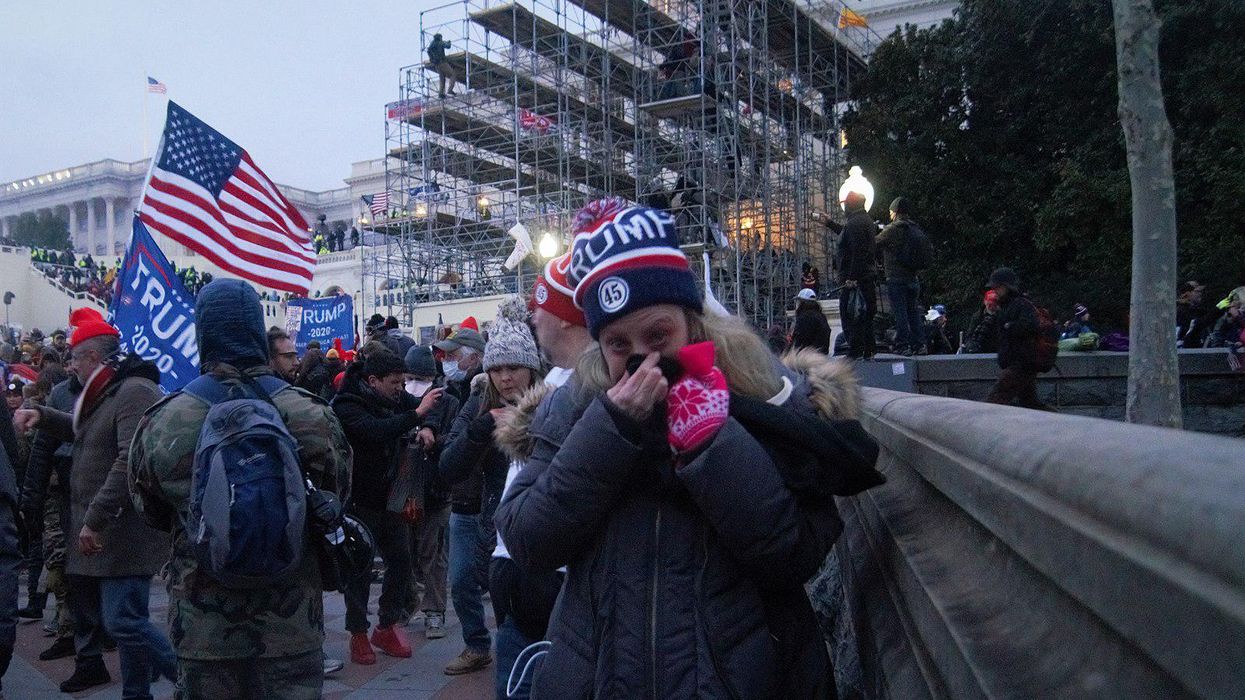Capitol Rioters’ Own Footage Powers New York Times ‘Day Of Rage’ Report

Capitol Rioters' Own Footage Powers New York Times 'Day Of Rage' Report
Reprinted with permission from American Independent
While some professional journalists faced hostility and attack while covering the January 6 riot at the U.S. Capitol, the grand irony is that so many people involved in the insurrection were doing their jobs for them.
That's evident with The New York Times' release of "Day of Rage," a 40-minute video investigation that painstakingly examines the events of the day. The Times' team collected thousands of videos, starting the afternoon of January 6, many of them posted on social media by the rioters themselves, said Malachy Browne, senior producer on the Times' visual investigations team.
"As the realization set in among many of the participants about what they had done, and the implications of it, much of it was deleted," Browne said.
Too late. The Times had already protected its own copies.
The day had been tough for some of the journalists who covered the attack. Photojournalists for The Associated Press and Times were roughed up, and some AP equipment used to document the event was damaged.
In "Day of Rage," the newspaper used the collected footage, as well as other material like police bodycam film and archived audio from police communications, to recreate the event from many angles. Through the use of time stamps and knowledge of where people were located, for example, the Times tracked down footage from a freelance videographer who hadn't realized he had captured the attack that led to Capitol Police Officer Brian Sicknick's death, Browne said. Sicknick collapsed and later died after engaging with the protesters. He was sprayed with chemical irritants, but a medical examiner determined he died of natural causes.
The Times was able to determine that rioters breached the Capitol at eight separate locations.
Elsewhere, the footage laid bare the intent of many rioters, like when former President Donald Trump's speech at the pre-riot rally were juxtaposed with what was said in his audience as he spoke.
The Times' probe concludes that the House's delay in shutting off debate on election certification until rioters had appeared outside the chamber contributed to the shooting by police of Ashli Babbitt, a California woman who had joined the crowd that breached the building.
The project depicts law enforcement as overwhelmed, partly due to lack of preparation by their superiors. The footage, some of it seen in other venues over the past months, contains startling moments: a police officer goading a rioter to move in one direction while senators slip to safety in the background, a House employee barricaded in an office whispering to a colleague while a door is being pounded from the outside.
While the footage spots efforts by members of the Proud Boys and Oath Keepers, showing their body armor, weapons, radio communication and organized movements, the Times concludes that the majority of rioters were Trump supporters caught up in the frenzy of the action.
"For many in the crowd, they felt they were carrying out some duty to defend democracy as they see it," Browne said.
The Times' story had nine bylines, but Browne estimated some 15 to 20 journalists participated in its preparation. Even before the documentary's release late Wednesday, the findings contributed to the newspaper's reporting about the incident over the past few months.
Browne, who also narrates the video, minces no words in telling viewers what was concluded.
"Our reconstruction shows the Capitol riot for what it was — a violent assault, encouraged by the president, on a seat of democracy that he vowed to protect," he says in the documentary.
The film also shows a congressman likening the rioters to tourists. "A tourist visit this was not," Browne narrates, "and the proof is in the footage."
The Times' investigation could take on added importance given the stalled government effort to thoroughly investigate what happened that day.
"I think recent events have made a presentation like this more valuable," he said. "Maybe it will create pressure for the investigation. I don't know. Our intention is not to influence policy or politicians, but to really show the public what happened in the fullest way possible."
- Trumpists Made Plans To Build Gallows Weeks Before Capitol Riot ... ›
- For Defending Capitol Rioters, Rep. Gosar Faces Censure And ... ›
- Trump Defense Secretary Disarmed D.C. National Guard Before ... ›
- FBI Director Testifies Capitol Rioters Carried 'All Sorts Of Weapons ... ›
- Greene Objects To FBI 'Targeting' Capitol Rioters - National Memo ›
- FBI Probe Uncovered Virginia Extremists Making Bombs In Wake Of January 6 ›
- Capitol Rioter Who Sought To Lynch Pelosi Cites ‘Biblical’ Defense - National Memo ›
- Gaslighting Right-Wing Pundits Whitewash Jan. 6 Insurrection ›
- Oath Keepers Seek Plea Deals In Jan. 6 Insurrection Conspiracy - National Memo ›
- GOP Extremists Plot Stunt For Jan. 6 ‘Political Prisoners’ - National Memo ›
- The Capitol Riot Aftermath Bodes Ill For Democracy - National Memo ›
- Saturday’s Far-Right Rally In Washington Expected To Flop ›
- More than a dozen Capitol rioters have pleaded guilty – San ... ›
- Capitol rioters' footage powers NYT's 'Day of Rage' project ... ›
- Capitol rioters smashing media equipment prompt several new ... ›
- More guilty pleas expected from U.S. Capitol rioters linked to Oath ... ›
- Capitol rioters' footage powers NYT's 'Day of Rage' project - ABC ... ›
- Day of Rage: An In-Depth Look at How a Mob Stormed the Capitol ... ›
- Capitol rioters' footage powers NYT's 'Day of Rage' project ›








